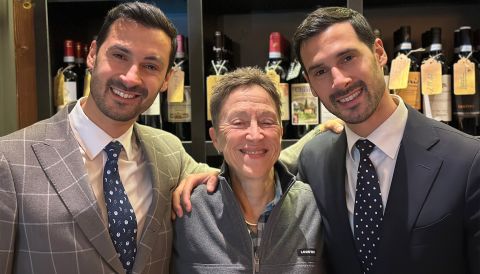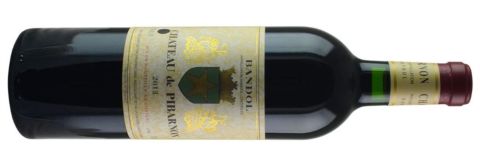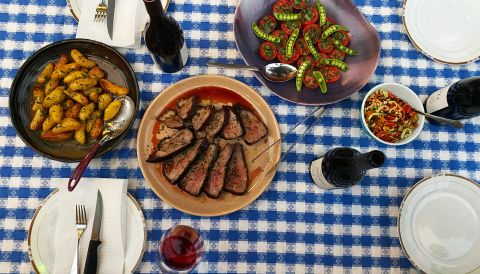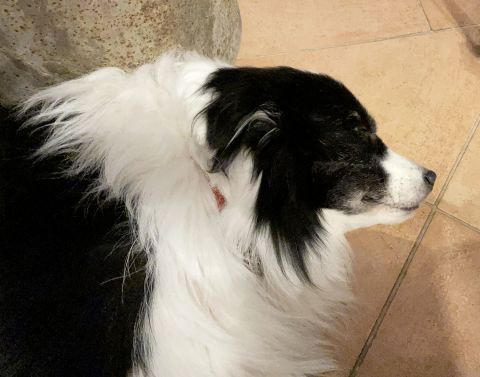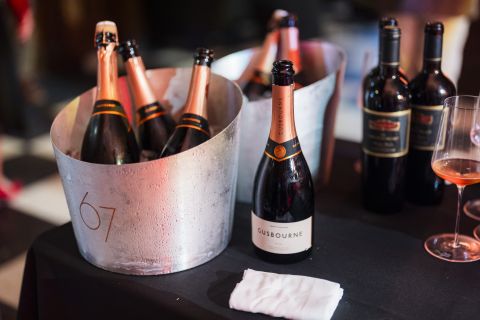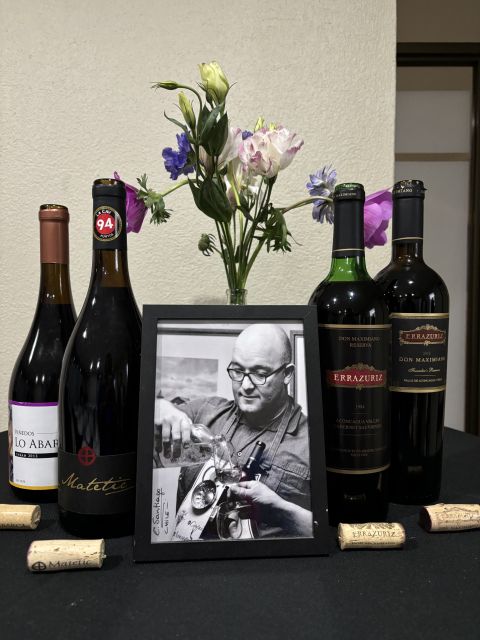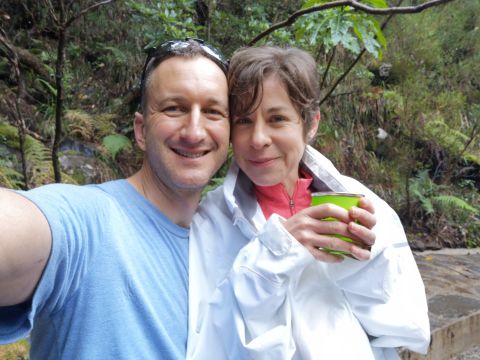Reasons to be grateful

The wines, and other drinks, that brought our critics the most joy, hope, solace and reassurance this year.
Sometimes a wine is just something to drink that’s more interesting than water. But then there are those moments when it does the thing few other beverages can do: it forms connection, forges bonds between you and a time, a place, a person. Sometimes, wine is the tether to a treasured memory, or the root of a new one. When this happens, it’s cause for celebration, as it’s a reminder that, even when everything is going up in flames, good things do still exist. On the eve of Thanksgiving in the US, and the festive season worldwide, our writers look back to some of the wines that brought them the most joy, solace and connection in 2024.
Gin and lime
Jancis writes I’m completely foxed. The brief is to choose one single wine from the thousands I taste or drink every year. I always deliberately shy away from the questions ‘What’s your favourite wine?’ and ‘Which is the best wine you’ve ever had?’, however often they’re asked.
In this case it seems I have to choose a wine that comforted me, but I have such an optimistic nature and (so far) such a charmed life that I’m racking my brains to think of any low point this year.
Even my six weeks in bed and eight nights in hospital with double pneumonia at the beginning of the year felt more like an intriguingly novel experience than a disaster. But I suppose I could choose a drink that saw me through the darkest days pre diagnosis and, post hospital, when I was put on an antibiotic, clarithromycin, that had the effect of making all wine taste like liquid iron. I wondered whether I would ever enjoy wine again.
Of course water – such a wonderful drink – was my special friend then, when most other drinks also tasted foul. But I did find one drink I could enjoy at the cocktail hour whenever I was strong enough to get up and sip it to mark the end of the day. I’d never usually choose to drink gin, but we had masses of the stuff in our drinks cupboard so I experimented with a gin and tonic. The tonic tasted just as disgusting as wine did (and, dear reader, I tried every kind of wine I could think of in the hope of finding one that didn’t taste bitter and metallic).
Then a childhood memory of adults drinking gin and lime cordial came back to me. My blessed husband scoured Waitrose in search of Rose’s lime-juice cordial. Seems there’s not much call for it in King’s Cross, but he did manage to find a bottle of Waitrose’s own-label version. And – what do you know? – the sweetness and the citrus tang just did the trick when mixed with gin and ice cubes. And the clink of the cubes made me feel like an adult rather than a patient, too.
I’m told the gin craze is waning, but I was very grateful to catch it on the tail end. And finally, by the very end of February, the effects of clarithromycin had worn off and my joy in wine returned – so much so that I was able to start going to tastings again, albeit seated initially. As much as I was delighted and comforted by wine again, I was at least as touched by the warm and solicitous welcome of my fellow wine writers when I was back on the tasting circuit. It’s the love of wine that so magically ties us all together.
López de Heredia, Viña Tondonia Rosado Gran Reserva 2012 Rioja
Julia Harding MW writes If only I had written a tasting note, I could have described this fabulous, mature, and complex rosé in more detail. Primary fruit flavours have evolved into something more savoury even if the fruit is still the foundation, the moderate tannins and acidity provide the lived-in structure. But I was too busy relaxing and enjoying myself in the company of dashing sommelier twins Alberto and Augusto Gherardi in Giovanna’s, my local, home-from-home Italian deli and pizza restaurant.
It was a cold November evening; the temperature had dropped to just above freezing in London. But mostly it was cold because my beloved wife was away for three weeks. Charmingly warm-hearted Augusto and Alberto run the sommelier training for Gordon Ramsay’s restaurant empire, both are studying for their Master of Wine, both are smart, hard-working, obsessed with wine in the best sort of way and immensely kind. Their generosity in sharing this treasured bottle warmed me from head to toe, and, served cool but not chilled, the wine was outrageously versatile with mixed antipasti and wood-fired pizza draped, equally generously, in pancetta, smoked scamorza and wild mushrooms.
Château de Pibarnon 2013 Bandol
Oliver Coleman writes On one of the rare sunny days this July, our eldest son had his last day at the village school. He was ready to leave, though I’m not sure we were. Parents have a habit of placing outsized significance on every milestone, but there is a wistful sadness when your child leaves the coddled certainties of the early years for something rather more worldly. By the end of his final day, our spirits needed lifting. Among the wines I’d collected from his birth year was a case of Château Pibarnon 2013, which, I reckoned, stood a decent chance of lasting the 18 years (or so) required for him to enjoy it. Aside from being the same age as my son, the wine’s warm generosity seemed a suitable choice for that balmy late afternoon. As we sat in a sun-dappled spot under our apple tree, gorging on a rib of beef, the broad, deep, enveloping tones of the Bandol, with its garrigue-y, leathery, meaty, spiced delights, melted away any lingering melancholy, pensiveness or trepidation, leaving only a glowing gratitude for a good seven years passed. It was one of those ‘spots of time’ – as Wordsworth called them – which both nourish and repair.
Ardnamurchan A/D 10.21:06 Highland Single Malt Scotch Whisky
Dave Broom writes The whisky I’m most thankful for? A leading question. Is it the one reached for as a reward at the end of a long day, or the one to settle a niggle of irritation? Though it could be the Powers dating from the 1950s, poured for me by Fionnán O’Connor: all clinging oils, wet earth, turps, garden shed, apricots and dried fruit. A taste of the past. Might it be the complex, fruit-forward new make from Diageo’s just-opened Yuntuo (云拓) distillery in Yunnan – a taste of a fascinating future for Chinese single malt? A bottle which is actually available might be better suited for you, dear reader, so it is the first 10 Year Old from the Ardnamurchan distillery (labelled as A/D 10.21:06) in the west coast of Scotland, a celebration of it reaching its first decade (no easy task for any new site). It has the old ‘west coast’ style: saline, oily, unctuous, gently smoked yet sweet. Long, elegant yet fresh, it’s a fusion of sea loch and orchard. A taste of the present. It’s what I’ll be reaching for this festive season.
J P Martin, De Tiza Pinot Noir 2021 Valle de Huasco
Alistair Cooper MW writes A wine that I am thankful for this year is one that I have very recently tasted in Chile and is therefore at the forefront of my mind. It is a wine that really shows the progression of Pinot Noir in Chile. While living in Chile over 20 years ago, the quality of Pinot Noir (for various reasons including poor clonal selection) was not the greatest. Yet over the last decade there has been a real surge in quality and styles, and the 2021 Pinot Noir De Tiza from J P Martin really demonstrates this. It comes from Huasco in the Atacama – an unlikely place for great Pinot, perhaps – but it’s made by a very talented winemaker and is elegant, refined and sappy – a beautiful wine that shows such promise for the future.
Sacred Shores, Treos Vineyard Sangiovese 2021 Willamette Valley
Sam Cole-Johnson writes Every Tuesday evening at around 7 pm, I either knock on a door or someone knocks on mine. Coats are hung, shoes are discarded, bagged bottles are lined up and between five and eight of us, depending on the week, cram ourselves into the kitchen of whoever has cooking duty. We then proceed to impede their movement, talk at them and steal from their mise en place. The cook, for their part, gamely shoves past, pours wine, and unsuccessfully tries to shoo people out.
My friend John Soares, whose wines I will likely never score (conflict of interest – too much time in his kitchen) has, with his friend Andrew Riechers (who makes Pinot Noir and Chardonnay under the label Audeant), managed to make the wine incarnation of Tuesday dinners – a well-structured, spicy, generous, joyful, energetic Sangiovese that loves food. It was presented to us one summer evening alongside dry-aged tri-tip, roasted fingerling potatoes and tomato salad with snap peas. I eagerly await its official release in the spring (the 2022, which was more approachable young, has already been released).
Vieux Château Certan 2009 Pomerol
Nick Lander writes This was a bottle of Vieux Château Certan 2009 which I drank over supper last night with Jancis and Julia. It had been outside our ‘cellar’ for 10 days and was given to us by Jacques Thienpont and Fiona Morrison MW the week before. Given to us by friends and enjoyed with another friend. It was delicious. It reminded me of the sheer pleasure of drinking mature bordeaux. It went with the food: cold lamb, potatoes and a salad of aubergines, tahini and sticky dates. And the wine brought me solace when the other two talked non-stop about wine …
Petite Arvine 2024 tasted at the Australian Alternative Varieties Wine Show in Mildura in early November
Max Allen writes The first trial batch (just 40 litres!) from the first crop of baby Petite Arvine vines brought into Australia a few years ago by visionary viticulturist Mark Walpole. This wine was made in early 2024 from mother vines planted at Chalmers nursery block near Mildura: Walpole has since planted two acres (0.8 ha) of the variety, propagated from those mother vines, at his Beechworth vineyard. It’s always a thrill to taste the inaugural expression of a grape that’s never been grown here before, but this was particularly goose-bumpy: not just because it was seriously delicious (beautifully textural, yellow-fruited, savoury finish) but also because it reminded me that, after two tumultuous centuries, Australia’s wine story is still being written – and the best could well be yet to come.
Anayón Garnacha Blanca 2018 Cariñena
Ferran Centelles writes In the 19th century, Cariñena was the wine of kings, gracing the table of King Alfonso XII, who used it to dazzle his guests, often pairing it with the traditional Spanish stew, cocido. Cariñena is a region with immense potential, a land of old vines that I will never tire of championing. In the stony soils of Cariñena, time-weathered vines produce intense Garnacha grapes, which local growers bring to co-operatives. Among these, my favourite is Grandes Vinos, a collective of 700 farmers cultivating 4,500 hectares (11,120 acres). The value for money in their wines is exceptional. One wine, in particular, stands out as almost magical: the Anayón Garnacha Blanca.
Crafted by Pilar Larumbe, an agronomic engineer, this is one of the rare few non-fortified oxidative white wines. Let me repeat: oxidative yet non-fortified – a true rarity. With its amber hue, flavours of dried fruits and hints of cedar, it surprises with its freshness and depth. The wine is macerated with the skins for six hours and aged for 40 months in American oak barrels. It offers aromas of dried apricot and cedar, coupled with a remarkable vibrancy and nerve. It’s a spectacular wine – and at an incredible price point (under €15 at Evinos.es).
Rocca delle Macìe, Famiglia Zingarelli 2021 Chianti Classico
Tara Q Thomas writes As wine writers, we are always looking for wines that dazzle, impress us with their ability to transmit a sense of place, person, energy – wines worth going out of our way to tell you, the reader, about. In that quest, though, it can be easy to overlook wine’s most basic purpose: to bring us together. That was brought home to me last January, after my dad, sister and I spent two weeks in a hospital room watching my mother die. Completely spent, confused and overwhelmed, we eventually stumbled out of the hospital and into a cold, snowy night. With the beams on low and the windshield wipers on high, we slowly drove to the nearest Olive Garden (which might seem like a strange choice but there are not so many choices). Sitting in a quiet booth, eating hot, puffy breadsticks, I ordered the one not-sweet red wine on the list: a Rocca delle Macie 2021 Chianti Classico. As we slowly unwound, dad looked at the bottle, surprised, and told us a story we’d never heard before: Chianti was the wine they courted over, and ‘their’ wine for years to come.
Rafael Palacios, Louro do Bolo Godello 2023 Valdeorras
James Lawther MW writes If solace and comfort also imply reliability, availability and ‘hitting the spot’, Rafael Palacios’ Louro do Bolo has been my pick this year (and in previous years). The fruit and tension are always pitch-perfect and there’s an undertow of sophistication afforded by the deft use of oak (there’s only a whisper). It’s a wine that always surpasses expectation and one that highlights the treasure trove of characterful wines to be found in Galicia in the north-west of Spain. And this from a wine that is produced in generous volume and retailed at a very affordable price (€23 at my local wine merchant).
Klein Constantia, Vin de Constance 2018 Constantia
Matthew Hayes writes On 14 February I had to put down my 16-year-old Labrador, Duplo. Duplo was the offspring of Emile, who arrived on the scene back in 2000 and was himself the offspring of my parents’ dog, Finbar. The line, alas, goes no further, but what a delicious way to celebrate 35 years of canine constancy was Vin de Constance. With the help of a Coravin I was able to stretch the memory over six months. The bottle is sitting on my desk. Duplo (and Emile), gone but not forgotten.
Vermentino in Costa Argentario
Walter Speller writes Travel alone gets lonely, especially when exploring terra incognita, even if every trip enriches, exhilarates and teaches me, time and again, that the Italian wine world is ancient, timeless and filled with people who allow you a deep look into their work and, therefore, into their private lives. But to pack the bags (again) get in the car and drive hundreds of miles to an unknown place makes me often wonder if I lead this nomad life, or if it is leading me. It is at that moment I want to rebel, stay at home, cook carbonara, play with Ludwig, our dog, and chat with my husband in the kitchen, while the cooking pasta water steams up the windows.
Recently, such a trip was to Costa Argentario where I went to research Ansonica, a white grape originating from Sicily. As a child I had seen plenty of pictures of Argentario in the magazines my mother read, with stories of the Dutch royal family’s summer retreat, L’Elefante Bianco, a whitewashed Mediterranean dream reflecting the dazzling summer sun against the azure sea on the Argentario peninsula. But when I arrive it is pitch dark and my accommodation is far away from this childhood multicolour dream, up an inland road that ends in a secluded enclave with 19th-century houses around a muddy square. The soft light of a trattoria gives me hope, which leaves me as soon as I enter my room, located in the cold, damp basement of one of the houses.
My host, a jovial man, tells me matter-of-factly that there will be no breakfast, but I can send him a text and he will bring down an espresso in the morning. I decline politely and ask him about the trattoria. ‘It is always fully booked on Saturday evenings’, he tells me. Already feeling low, this announcement sends me into a full depression. ‘But I can ask.’ Five minutes later a text message: the signora who runs the trattoria has confirmed: the joint is packed to the rafters. But … she will try to get me table.
I put on my coat and head towards the warm yellow light of the trattoria. Outside a woman who reminds me of Sigourney Weaver is sitting on a small chair smoking a cigarette. On my approach she asks: are you so-and-so? I confirm I am. ‘Have a seat. I think there is a no-show.’ Out of courtesy for people who, without cancelling, simply will not turn up, she is prepared to wait another 10 minutes. By then, they will be a full hour late. I think of the last time I frantically called a London restaurant to tell them I will be 10 minutes late.
Right at that moment, one of the staff comes out. ‘Have a seat’, she tells me, and asks the young man, ‘Can you bring another glass?’ which, after it has been put in front of me, she fills with white wine. An aperitif that will never appear on the final bill. I ask what it is. A Vermentino. Stainless steel, squeaky clean, with hints of tropical fruit and just verging away from the fatal cliff of banality so many of these wines tumble over.
While we chat about the trattoria (‘I don’t know if I can run it much longer, you see’), about what I am doing here (Ansonica dragging me out of my comfort zone), a sense of gratitude and relaxation rolls over me. Then: there is a table free. I thank my gracious hostess, walk inside and sit down. While studying the menu, a Border collie who seems to own the restaurant comes over and lays its head on my shoes. I take another sip of the Vermentino.
Famille Hugel, Schoelhammer Riesling 2014 Alsace
Alder Yarrow writes Tasting thousands of wines per year can, if we wine writers are not careful, easily lead to a jaded palate, especially when the vast majority of what we taste hovers somewhere between mediocre and very good. It proves wonderful, then, to occasionally be jolted out of the wagon rut of our daily expectations by wines that are truly transcendent. They’re a delicious window into the apogees of experience that fuel our ongoing passion for wine. The wine that knocked me upside the head this year was the 2014 Famille Hugel Riesling Schoelhammer from Alsace, France. It wiped the slate of my palate clean and rung it like the chime of a prayer bowl, focusing my attention utterly for some moments as waves of flavour and texture carried me to that place that only the most profound wines take us, a place that is simultaneously inside and outside of ourselves. I wouldn’t have said that I needed reminding of just how much I love wine, but when that reminder showed up in a glass, it was deeply appreciated.
Heineken Zero … and Gusbourne Rosé, Errázuriz Don Maximiano Founder’s Reserve, Juliet Victor Szent Tamás Dry Furmint
Richard Hemming MW writes My honest answer? Heineken Zero is the drink I’m most thankful for this year, and so is my hepatologist. But an equally honest answer would be a trio of wines: a delightful sparkling rosé from English fizz royalty Gusbourne, supercharged Chilean red Don Maximiano, and Juliet Victor’s profound dry Furmint from the Szent Tamás vineyard in Tokaj, Hungary. These three have just one thing in common: they sponsored the inaugural wine communication competition that had its first year in 2024 (and in which Sam C-J of this parish was a very worthy double-finalist).
For their support of those awards, I am most exceedingly thankful – and they are also wines that I’ve tasted, enjoyed and written about multiple times over the years, so it felt like a most virtuous circle. These drinks have been a significant force for good in my year, in very different ways. In the second case, it’s thanks for everything; in the first case, it’s thanks for nothing.
Errázuriz, Don Maximiano Founder’s Reserve 1984 Aconcagua
Amanda Barnes writes One of my best friends died far too young of a sudden heart attack in June 2023. Rodrigo Pica was my wine soulmate, a trusted confidant I had been fortunate enough to consider as my ‘family’ for many years. To commemorate his passing one year later, his wonderful wife and mother of their two young children Francisca invited me to do a wine tasting for his friends and colleagues with some special wines Rodrigo had squirrelled away. It was cathartic to spend the day together organising his cellar and remembering better times. Rodrigo was the most enthusiastic oenophile I have ever met – he had an encyclopaedic knowledge and an irrepressible joie de vivre. He was the opposite of a wine snob – he would just as happily drink cheap País as top Cabernet. But there’s one wine that was particularly special to him: Errázuriz, Don Maximiano. He had been collecting Don Max for years, and – I still don’t know how he got his hands on this one – he had a bottle of 1984, one of the first vintages and a piece of Chilean wine history. We shared it that night in his honour, and it was glorious – earthy, fragrant and complex.
We opened lots of old wines that night, wines that probably should never have been held back that long, and every bottle was perfect. No taints, no flaws, no leaky corks, they were all delicious. The wine flowed, the tears flowed, and – most of all – laughter flowed. No one went to bed early that night, just as Rodrigo would have wanted.
Domaine d’Escausses, La Vigne de l’Oubli 2019 Gaillac
Andy Howard MW writes We first visited Gaillac in 1994, purchasing a house there in 2001. Back in the late 1990s, nearly all Gaillac white wines were ‘old-fashioned’ and oxidative (to say the least). The one exception was Le Vigne l’Oubli – an oaked Sauvignon Blanc blended with a small part of Muscadelle – made by the Balaran family at Domaine d’Escausses. Back then we reckoned it was comparable to top-end white bordeaux. Almost a quarter of a century later, we have put our house on the market (and are open to offers!) but when I tasted the latest release (2019) I was stunned at how good this wine is. Lesser-known AOPs and regions need flag-bearers and the Balaran family continue to drive a new generation of young winemakers in Gaillac. A constant over 25 years – and great value at €12 a bottle – this continues to transport me back to south-west France and will always be one of my favourite wines.
Le Tribute tonic water
Paula Sidore writes Over the course of a 125+ mile thru-hike in northern Spain, I found myself thankful for water – in its many and varied forms. For the plastic bladder on my back to keep me hydrated through the difficult elevation gains; for the expansive views and pounding surf of the salty Atlantic to infuse and inspire me to keep going; for the (copious) rain to cool me down; for the tears required to release the emotions accumulated along the way. For Le Tribute tonic water.
According to Merriam-Webster, a tribute is an act, statement or gift intended to show gratitude, respect or admiration. And Le Tribute, the first thing I drank after touching the final lighthouse on the walk – the culmination of over a decade of dreaming – tasted of all three. Far more citrusy and herbal than most, the characteristic quinine bite took a backseat to a delicate tang and spice. It smelled of the eucalyptus stands and lemon trees I had passed over the course of the walk, the swathes of wild fennel and rosemary bushes as tall as I am, a delicate shaping bitterness underscored with a spruce-like spice. And a perfect pairing with the locally made Nordes gin.
Rainwater Madeira
Tamlyn Currin writes The wine I’m thankful for was the wine I started 2024 with, so it seems fitting that I would end 2024 with it too – Rainwater Madeira. It’s a wine that comforts, reassures, steadies and brings hope on so many levels and I’m thankful for this wine for many reasons. It offers sweetness (which has throughout history brought comfort to living creatures) but it is not as powerfully sweet as a Malmsey or Boal, and crucially the sweetness comes with Madeira’s signature tang and acidity, which means that the wine uplifts and energises at the same time as it brings comfort. This makes it a wine I’m thankful for on days when I am exhausted or low or feeling the heaviness of winter as the darkness closes in. Its mouth-watering freshness means it is thirst-quenching, especially when chilled, so I am thankful I can sip it with as much pleasure on a hot day in summer as I do when it’s snowing outside. It offers flavour and depth without demanding intellect or exerting power, so it’s a wine I am thankful for after long days when brain and soul have been taxed to the limit. It’s not as gloriously complex as older Madeiras, but it also doesn’t cost nearly as much, and I am thankful for its affordability. It is a wine with a long history but also a wine that has seen the doldrums and crests of fortune, and I am thankful for the reminder that good things find a way to survive. I am thankful for its tenacity and for the tenacity and vision of the people who revived this style of Madeira for us to enjoy. I am thankful that, like all Madeira, I can open a bottle and sip it slowly over days or weeks or months.
I’m thankful that if I bought a case and ended up living in a caravan, it’s the one wine that could come with me because it needs neither fridge nor cellar nor still dark cupboard to store it in. I am thankful for a wine which defies the odds, coming from vines clinging to the impossible slopes of a tiny volcanic outcrop in the middle of a huge ocean, jostling for space with banana trees and passion-fruit vines, subjected to heat and oxygen, and aged for 10 years before being bottled. I am thankful for a wine that has survived Prohibition, world wars, trade wars, environmental catastrophes and industrialisation. If Rainwater Madeira can do this, we all can.
Photo at the top of this article is by Diego PH on Unsplash.
Become a member to view this article and thousands more!
- 15,406 featured articles
- 274,946 wine reviews
- Maps from The World Atlas of Wine, 8th edition (RRP £50)
- The Oxford Companion to Wine, 5th edition (RRP £50)
- Members’ forum
- 15,406 featured articles
- 274,946 wine reviews
- Maps from The World Atlas of Wine, 8th edition (RRP £50)
- The Oxford Companion to Wine, 5th edition (RRP £50)
- Members’ forum
- Commercial use of our Tasting Notes

